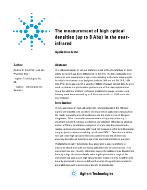

|
Highlights from the April 2013 issue of Photonics Spectra
|


|
With Infrared, Military Owns More Than the Night
Thanks to improvements in the resolution and capability of IR sensors, defense agencies can not only detect targets, but also determine intent. At the US Army’s Night Vision and Electronic Sensors Directorate, the goal is to see – day or night – through smoke, fog, dust or any other airborne obscurant. The directorate conducts sensor research and development so that soldiers can see effectively in a variety of conditions. This capability is important so that soldiers can tell whether someone is holding a hoe or a rifle. And seeing more clearly can better reveal intent, an important piece of information.
|
|
|
|

Advances in Standoff Detection Make the World Safer
Worldwide, government agencies and military branches are tasked with the formidable job of identifying evolving threats to national security such as concealed explosives, improvised explosive devices (IEDs), and airborne chemical and biological materials – without putting equipment or people in harm’s way. Lasers and optical techniques are of critical importance to standoff detection technology for their ability to passively and actively probe threats near and far.
|
|
|
|

ITAR: Keeping the US Safe or a Global Trade Headache?
Whether you view ITAR as a necessary and justifiable control helping to safeguard US national security or as a roadblock to reaching the global market, any US photonics company that wants to trade ITAR-controlled products abroad must abide by its rules. The export and import of all defense articles and services listed on the United States Munitions List are controlled by the International Traffic in Arms Regulations, administered by the US State Department’s Directorate of Defense Trade Controls.
|
|
|
|

Software Unites Vision and Robotics
Advances in processing technologies and other software functions suggest a host of new vision-guided robotics applications. For decades, vision has been making its way into industrial automation applications, with one of the most common uses being vision-guided robotics, especially in areas such as assembly and materials handling. The process is not new, but it is growing: The need to increase productivity and quality in manufacturing is driving the adoption of more and more robotic systems.
|
|
|
|

Coupled Waveguide Technology Enables Multiple Imaging Advances
This approach enables not only wide-range tunable filters, but also an image demultiplexer that forms the core of a multispectral imaging system that captures high-resolution images in real time over a broad wavelength range. Waveguide technology is the basis for a wide variety of optical devices, including filters and demultiplexers. Perhaps the simplest and most well-studied are planar waveguides, which are simply stacks of optical materials arranged in such a way that optical energy can flow along one or more of the layers.
|
|
|
|

Hybrid LEDs Pave Way to New Lighting Applications
Low-cost Lumogen dyes can give white LEDs high quantum yield, reduced environmental impact and more. Many analysts agree that the global lighting market is close to a real revolution: the LED revolution. In fact, the global lighting market is expected to produce profits of around €100 billion in 2020. This revolution may be ascribed to the great efficiencies of LED lamps, which offer less energy consumption.
|
|
|
|






|
The Measurement of High Optical Densities (up to 8 Abs) in the Near-Infrared
Agilent Technologies, Inc.
The optical densities of various materials used in the manufacture of laser safety eyewear have been determined in the NIR. The lens materials were measured over wavelength ranges corresponding to the laser wavelengths for which the eyewear was designed (InGaAs, 980 nm and Nd:YAG, 1064 nm). Prior to measurement, a variety of filters of known optical density were used to validate the photometric performance of the spectrophotometer. Using the addition of filters technique, photometric range, accuracy and linearity were demonstrated up to 8 Absorbance units at 1200 nm in the near-infrared.
DOWNLOAD WHITE PAPER >>
|

|

|


Follow Photonics Media on Facebook and Twitter
|
 

|
|

sponsor
 |


sponsor
 |

sponsor
.jpg) |

sponsor
 |

sponsor
 |

|